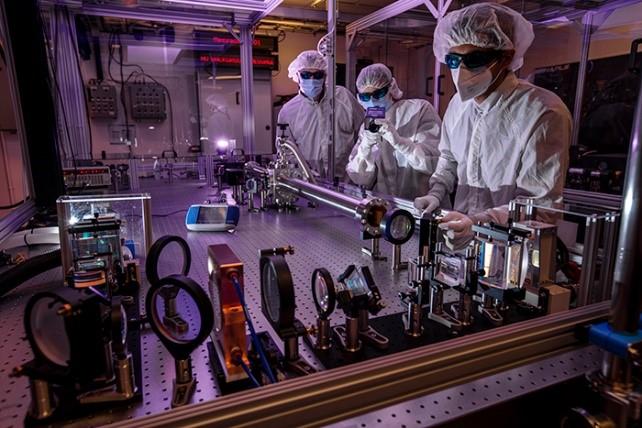Scaling state-of-the-art laser systems towards higher peak powers is a costly, time-intensive, and difficult endeavor. Traditionally, only increases in the laser pulse energy, following an aperture expansion of the final amplifier and compressor, are possible, as the pulse duration has already been optimized near the shortest possible value set by the design of the chirped pulse amplification (CPA) system. There is a need for an inexpensive, efficient method to shorten the pulse duration, scale the peak power, and enable advanced experimental capabilities (e.g., laser-driven wake-field acceleration) for current and next-generation laser systems worldwide that can be installed within any high peak power laser system without modifying the existing CPA chain.
This invention proposes the use of a nonlinear spectral broadening subsystem as a post-CPA pulse compression add-on for high energy laser systems. The proposed solution utilizes the beam profile of a high peak power laser as a reference to shape a highly transmissive nonlinear plastic (e.g., CR39) itself to ensure a spatially homogeneous nonlinear spectral broadening. An optical path difference (OPD) compensator is then installed to eliminate spatio-temporal effects arising from the shaped plastic, and the materials are edge-bonded to a face-cooled mirror to mitigate thermal effects and enable high repetition rate operation. By exploiting a well-known nonlinear broadening mechanism in an innovative manner, this scalable post-CPA pulse compression technique would allow for substantial peak power enhancements and could be readily applied to real, high energy laser systems at high repetition rates.
Publication:
I. Tamer, M. Hornung, L. Lukas, M. Hellwing, S. Keppler, R. Van Hull, J. Hein, M. Zepf, and M. C. Kaluza, "Characterization and application of nonlinear plastic materials for post-CPA pulse compression," Opt. Lett. 45, 6575-6578 (2020) (https://doi.org/10.1364/OL.409637)
- Enables inexpensive, efficient scaling of state-of-the-art laser systems towards higher peak powers.
- Directly increases laser peak power, while maintaining overall system efficiency and repetition rate.
- Enables advanced experimental capabilities e.g., laser-driven wake-field acceleration.
- Strong spectral broadening induced by this invention allows the end-user to bypass gain-narrowing limitations.
- Can be installed within any high peak power laser system without modifying the existing CPA chain.
An enabling component of high-power and ultrafast laser systems
Current stage of technology development: TRL 2-3
LLNL has filed for patent protection on this invention.
PCT Application No. PCT/US2021/072670 Spatially Homogeneous Nonlinear Spectral Broadening published 6/8/2023.


